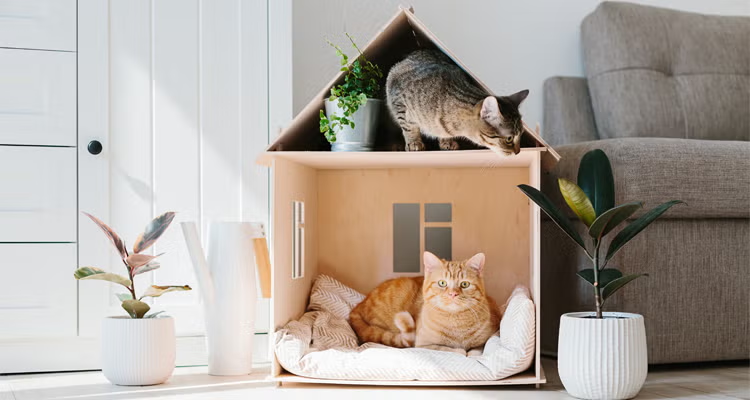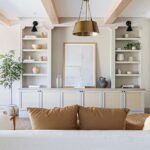Finding that sweet spot where your home works for both your two-legged and four-legged family members isn’t always easy.
When I first brought my rescue mutt Benny home, I quickly realized my pristine white couches and glass coffee tables weren’t going to cut it.
After some trial, error, and more than a few accidents on the carpet, I’ve figured out how to create spaces that keep everyone happy.
Let me share what I’ve learned about making a home that looks good and functions great for all its occupants, no matter how many legs they walk on.
Things to Consider to Make Your Home Human and Pet Friendly Without Compromise
The average pet owner spends about $1,500 annually on their pets, according to the American Pet Products Association. A good chunk of that goes toward cleaning supplies and replacing damaged items. But with some smart planning, you can reduce those costs while creating a space everyone loves.
Get Flooring That Works for Everyone
Your floors take the biggest beating from pets. After replacing my light beige carpet twice (big mistake), I learned that certain flooring options just work better with animals around.
Luxury vinyl plank has been my saving grace. It looks like real wood but stands up to scratches and accidents way better. And it costs about 30-50% less than hardwood. Tile works great in kitchens and bathrooms too—just watch out for slippery surfaces that might be tough on older pets.
What about carpet? If you must have it, opt for low-pile versions in darker colors or patterns that hide fur. I put carpet only in bedrooms now and stick with washable area rugs elsewhere.
A funny thing I noticed—my cat actually prefers the cooler tile surfaces during summer, while gravitating to carpet in winter. Your pets have preferences too!
Rugs and Mats That Are Easy to Clean
Speaking of rugs, they’re not all created equal when it comes to pet friendliness. Indoor/outdoor rugs have been total game changers in my house. They look stylish inside but can handle mud, accidents, and spills.
I keep washable mats by every door because Benny has this magical ability to find every mud puddle within a five-mile radius of our walks. My neighbor Lisa skipped this step and spent three times more on professional carpet cleaning last year alone.
For rugs, natural fibers like sisal might seem durable, but they absorb odors like crazy. Synthetic options with low pile work much better and many now come in machine-washable versions.
Incorporate Safe and Stylish Décor
You don’t have to give up on having nice things just because you have pets. My friend Jake used to keep all his nice decor packed away “until the dog calms down”—spoiler alert: five years later, they’re still in boxes!
Instead, look for heavier, sturdier items that won’t tip easily. Replace delicate vases with weighted ones. Consider wall-mounted shelving for displaying fragile items out of reach.
About 68% of pet accidents with home decor happen with items placed on coffee tables or low shelves. Moving things up just a foot or two can make a huge difference!
I learned this lesson when my cat knocked over and broke my grandmother’s crystal vase. Now anything with sentimental value stays secured or elevated.
Create Designated Pet Friendly Areas
Pets love having their own spots. My dog has a corner in the living room with his bed and toys, and he actually respects our furniture more since creating this space for him.
These areas don’t have to be eyesores either. I built a window perch for my cat using the same wood as my shelving for a cohesive look. My sister bought a stylish end table that doubles as a dog bed—guests never even realize it’s pet furniture until her poodle crawls inside!
Setting up these zones works with your pet’s natural behaviors rather than constantly fighting against them. My cat scratched my couch until I put a scratching post right next to it. Problem solved.
Create No-Go Zones using gates or doors
Sometimes the best solution is separation. Baby gates work great for dogs, and there are now more attractive options than the plastic white ones from years ago.
I use a wood gate that matches my decor between the living room and dining room when we have dinner guests. About 40% of pet owners report using some form of pet gate or barrier in their homes.
For cats, it gets trickier since they can jump. My friend Sarah installed a cat door on her home office so her cats can come and go, but her important papers stay safe from curious paws.
Just remember that completely cutting pets off from family activities can cause anxiety. Balance is key here!
Prioritize Cleanliness
Let’s be honest, pets make messes. A good vacuum designed for pet hair is worth its weight in gold. I upgraded from a basic model to one specifically for pet hair and was shocked at how much more fur it picked up.
Regular cleaning schedules help prevent buildup. I do a quick vacuum every other day rather than a deep clean once a week. This takes less time overall and keeps things consistently cleaner.
Grooming your pets regularly reduces shedding too. When I started brushing Benny outside three times a week, the amount of fur in my house dropped dramatically.
Use pet-friendly enzymatic cleaners
Not all cleaners are created equal when dealing with pet messes. Regular cleaners might mask odors temporarily, but enzymatic cleaners actually break down the proteins in accidents.
I learned this the hard way when Benny kept returning to the same spot on my rug despite cleaning it repeatedly. Once I switched to an enzymatic cleaner, the problem stopped because the scent was truly gone.
These cleaners are also safer for pets who might lick or walk on cleaned surfaces. About 27% of pet poisoning cases involve household cleaners, according to veterinary reports.
Blend Storage and Style
Smart storage solutions keep pet stuff organized without making your home look like a kennel. I found a vintage trunk at a flea market that now holds all of Benny’s toys, leashes, and treats.
Many pet owners find that storing precious items off-site in a storage unit provides peace while keeping their home open and welcoming.
If you work from home, you can also store important business inventory in a storage unit. Storing items in a unit is particularly helpful when house-training your pet, as they’ll need room to roam and may accidentally break vases or soil expensive rugs.
Also, wall-mounted leash holders by the door look decorative while serving a purpose. Pet food containers that match your kitchen decor keep food fresh and pests out while looking intentional.
My friend built a sliding drawer into his kitchen island for pet food and bowls. During meals, everything tucks away neatly but remains accessible.
Secure Hazardous Items
Pets are curious creatures. My cat once knocked over a bottle of pain relievers I left on the counter, and it could have been disastrous if I hadn’t caught it quickly.
Medications should always be stored in closed cabinets. Chocolate, xylitol, and other toxic foods need secure storage too. Child-proof latches work great for determined pets who’ve figured out how to open cabinets.
Cords and cables are another hazard. I use cord covers that match my baseboards to protect both my electronics and my pets. After spending $200 on a new lamp cord that my puppy chewed through, this felt like a bargain!
Keep the space Clutter Free
Clutter isn’t just visually stressful—it creates hiding spots for pet accidents and makes cleaning harder. When I decluttered my home last spring, cleaning time dropped by almost 40%.
Pets also tend to chew or play with random items left out. My cat’s favorite “toys” used to be my hair ties until I realized how dangerous it could be if she swallowed one.
Having proper places for everything means you’re more likely to put things away, and your pets have fewer opportunities to get into trouble.
Choose Non-Toxic Plants
I love houseplants, but many common varieties are toxic to pets. After a scary vet visit when Benny nibbled on a lily plant, I did a complete overhaul of my indoor garden.
Safe options like spider plants, Boston ferns, and areca palms now fill my home. They still purify the air and look beautiful without the risk. Nearly 5% of calls to pet poison hotlines involve houseplants, showing how common this issue is.
If you’re not sure about a plant, the ASPCA has a comprehensive online database you can check before bringing it home.
Opt for pet-safe products and materials
Beyond plants, many household items contain chemicals that can harm pets. Air fresheners, certain essential oils, and some cleaning products top the list.
I switched to natural alternatives where possible and keep the rest securely stored. Fabric choices matter too, stain-resistant treatments on some furniture can be harmful if pets lick or chew the material.
When shopping for new items, I always check if they’re pet-safe before bringing them home. This simple step has prevented numerous potential problems.
Use Elevated Bowls for Food Time
Raised feeding stations aren’t just stylish—they can be healthier for your pets, especially larger dogs or older animals with joint issues. My aging Lab mix eats much more comfortably from his elevated bowls.
These stations also help contain messes. I used to find kibble scattered several feet from Benny’s old floor bowl. The raised version with a lip around the edge keeps everything in place.
You can find stylish options that complement your decor or even build custom versions into cabinetry for a built-in look.
Have Built-in Perches or Cat Shelves
Cats naturally love heights. When I installed floating shelves creating a pathway up to my bookcase, my cat stopped climbing my curtains. Win-win!
These vertical spaces use wall real estate that would otherwise go unused. They give cats exercise, observation points, and satisfy their climbing instincts without sacrificing floor space.
About 78% of cat owners report destructive behavior decreases when cats have appropriate climbing options. The shelves don’t have to look “pet-ish” either—mine match my other shelving for a cohesive look.
Get Interactive Decor
Some pet items can double as decor. Modern cat trees now come in sleek designs that look like sculpture. Puzzle toys keep pets mentally stimulated and can be stored in decorative baskets when not in use.
My favorite coffee table has built-in pet puzzles that guests think are just interesting design elements. When Benny gets bored, I pull them out and keep him entertained.
Pet portraits make great wall art too. I commissioned a painting of Benny that’s now the focal point of my living room—it’s both meaningful and matches my color scheme.
Smart Devices for Pet Monitoring
Technology has changed pet ownership. I use a pet camera to check on Benny when I’m away, and it helps me identify problem behaviors I might miss otherwise.
Automatic feeders ensure pets eat on schedule even when your day gets chaotic. Smart water fountains encourage pets to drink more and alert you when the water needs changing.
These smart devices for home gives peace of mind while making pet care more convenient. After seeing Benny’s separation anxiety on camera, I was able to work with a trainer to address the issue before it became destructive.
Use multi-purpose furniture
Space-saving is crucial when accommodating pets. Look for furniture that serves multiple functions—ottomans with storage inside, sofas with washable covers, tables with built-in pet beds underneath.
I replaced my old coffee table with one that has a pull-out drawer containing Benny’s toys. They’re accessible when needed but hidden from view the rest of the time.
About 65% of pet owners say multi-functional furniture has improved both their living space and their relationship with their pets by reducing conflicts over space.
Maintain Ventilation and Air Quality
Pets bring odors, there’s no way around it. Good ventilation helps manage these smells without relying on artificial fresheners that might irritate sensitive pet noses.
Air purifiers with HEPA filters remove pet dander and fur from the air, which benefits both human allergy sufferers and the pets themselves. I noticed fewer respiratory issues in both Benny and myself after installing one.
Regular cleaning of vents and filters keeps everything flowing properly. When seasons change, I do a deep clean of all air systems in preparation.
Add a Cozy bed or cushion
Quality pet beds serve both pets and humans. My dog used to sleep on my couch until I found a memory foam bed that he actually prefers.
The trick is finding options that blend with your decor. I chose a bed with a cover that matches my living room color scheme, and it looks intentional rather than out of place.
Washable covers are non-negotiable. I have two sets so there’s always a clean one ready while the other is in the laundry.
Keep Litter Box clean
For cat owners, litter box management is crucial. Newer designs hide these necessary items while keeping them accessible to cats.
My litter box looks like a side table with an entrance hole for my cat. Guests never realize what it is unless I point it out. The enclosed design also helps contain odors and litter tracking.
Location matters too. Finding a spot that’s convenient for your cat but out of main living areas creates harmony for everyone. I tucked mine into a corner of the laundry room with a cat door for access.
Other considerations to Your Home Human and Pet Friendly Without Compromise
- Regular vet check-ups prevent health issues that might lead to household accidents
- Pet insurance helps cover unexpected costs from pet-related home damages
- Local pet training resources can address behavior problems before they affect your home
- Seasonal changes might require adjustments to your pet-friendly setup
- Consider your pet’s age and mobility when designing spaces
- Different breeds have different needs—research your specific pet’s tendencies
- Window treatments should have pet-safe cords or be cordless
- Soundproofing helps with barking issues in apartments or shared walls
- Weather considerations might affect how you set up entryways
- Guest comfort should balance with pet needs, especially for visitors with allergies
Conclusion
Creating a home that works for both humans and pets doesn’t mean sacrificing style or comfort. With thoughtful planning and creative solutions, you can have spaces that everyone enjoys.
The key is working with your pet’s natural behaviors rather than constantly fighting against them. By providing appropriate outlets for their instincts, you’ll reduce problem behaviors while maintaining a home you love.
Remember that perfection isn’t the goal, but the harmony is. Some days fur will fly and accidents will happen. But with these strategies in place, you’ll bounce back quickly and enjoy the unconditional love your pets bring to your home.
After all, our pets don’t care if our homes look perfect. They just want to share the space with the humans they love. And with these tips, you can create an environment where that love doesn’t come with a side of destroyed furniture or constant cleaning.



